Behavioural Assessment & Succession Planning
Succession planning is a strategic cornerstone for ensuring leadership continuity and stability. In a competitive, fast-moving environment, behavioural-assessment tools are becoming a decisive lever for identifying and developing tomorrow’s leaders.
This article explores how behavioural evaluation is reshaping succession planning, with a focus on best practices and emerging trends in the United States.
The Value of Behavioural Assessment in Succession
Behavioural assessments measure traits and behaviours that directly influence performance. They allow organisations to:
-
Identify high-potential talent
-
Tools such as the Predictive Index (PI) analyse dominance, extraversion, patience and accuracy to flag profiles best suited for leadership roles.
-
-
Align profiles with role requirements
-
Matching behavioural and cognitive traits to required competencies reduces the risk of ill-fitted promotions.
-
-
Design targeted development plans
-
The insights generated highlight strengths and growth areas, enabling personalised training programmes.
-
Innovative Trends in the United States
-
Psychometrics & AI
-
Psychometric tests integrated with AI algorithms analyse large data sets to predict potential and adaptability (e.g., Unilever reports a +25 % increase in leadership readiness).
-
Impact: faster, more accurate selection.
-
-
Ethical & inclusive approach
-
Validated assessments reduce bias and support diversity in leadership positions.
-
Impact: higher engagement and a stronger employer brand.
-
-
Personalised assessments
-
Platforms such as Hogan or PI generate profiles that include emotional intelligence and decision-making skills (cases at Siemens and Philips show +30 % internal promotions).
-
Impact: accelerated career paths.
-
-
Realistic simulations
-
Situational Judgement Tests and “in-box” exercises recreate real scenarios to assess problem-solving and stress management.
-
Impact: high predictive power for on-the-job performance.
-
Challenges to Manage
-
Internal acceptance – Some candidates may view the tests as intrusive; clear communication of their value is essential.
-
Algorithmic bias – AI models must be continuously monitored and recalibrated to prevent distortions.
-
Up-front investment – Customisation and integration require time and budget but deliver a strong medium-term ROI.
Conclusions
Behavioural assessment is redefining succession planning with a scientific, data-driven and inclusive approach. Companies that adopt validated psychometric tools and AI solutions:
-
enhance the quality of promotion and career-path decisions;
-
reduce bias and improve leadership diversity;
-
boost engagement through fair, transparent processes.
Investing in customised assessment platforms is therefore a key step toward sustainable, future-oriented talent management.







